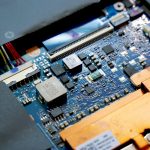The rapid growth of the virtual reality and mixed reality (VR/MR) market has sparked intense competition among display technologies. While LCD remains dominant in the mainstream near-eye display market, OLED is emerging as a strong contender, particularly in the high-end segment.
Sony and Apple’s collaboration on the Apple Vision Pro has given a significant boost to the adoption of OLED displays in high-end VR/MR devices. The use of CMOS and top-emitting OLED components in OLEDoS (Organic Light Emitting Diodes on Silicon) technology has enabled higher luminous efficiency and pushed the resolution beyond 3,000 PPI. This partnership has showcased the industry’s pursuit of high-resolution VR/MR devices and has brought increased attention to OLED as a display technology.
Despite its technological advancements, OLEDoS faces challenges in terms of production costs due to the complexity of CMOS manufacturing and lower yield rates. However, the increasing investment by Chinese manufacturers such as SeeYa and BOE in OLEDoS is expected to drive its future expansion in the VR/MR device market. TrendForce forecasts that OLEDoS’ market share will rise from 7% in 2024 to 23% in 2030.
On the other hand, LCD technology continues to dominate the mainstream market, primarily due to its cost-effectiveness. Nevertheless, as VR/MR devices strive for higher resolution and image quality, LCD products with their 1,200 PPI will face stiff competition from other technologies. TrendForce estimates a decrease of 5.6% in the shipment volume of LCD near-eye display products in 2024 compared to the previous year.
TrendForce highlights the potential for further optimization in LCD components, such as improving liquid crystal materials to reduce dizziness and upgrading backplane technology to achieve resolutions beyond 1,500 PPI. BOE’s continuous updates and iterations of LCD display specifications in VR/MR devices ensure that LCD technology remains competitive in the mid-to-low-end market. The report projects that LCD will hold a significant 63% market share by 2030.
In contrast, OLED technology faces limitations in its long-term penetration rate in the VR/MR market. Its use relies heavily on specific manufacturers, making it less competitive than OLEDoS in the high-end segment and unable to match the cost-effectiveness of LCD products. TrendForce predicts that OLED’s market share in the VR/MR market will remain between 13% and 15% from 2024 to 2030.
While OLEDoS displays are poised to dominate the high-end VR/MR market, LCD technology will retain its stronghold in the mainstream market. Both technologies continue to push the boundaries of resolution and image quality, presenting exciting opportunities for immersive visual experiences in the future.
Additional relevant facts:
– OLED displays offer several advantages over LCD displays in the VR/MR market. These advantages include deeper blacks, higher contrast ratios, faster response times, and wider viewing angles. These qualities make OLED displays well-suited for immersive experiences in virtual and mixed reality.
– OLED displays also have the ability to individually control each pixel’s brightness, resulting in more accurate and vibrant colors. This feature is particularly important in VR/MR applications where color accuracy enhances the overall visual experience.
– One key challenge for OLED technology in the VR/MR market is the issue of screen burn-in. OLED displays are more susceptible to burn-in, which occurs when static images are displayed for extended periods, leading to permanent image retention. However, manufacturers are implementing technologies such as pixel shifting and automatic brightness adjustments to mitigate this issue.
– Another challenge associated with OLED displays is their relatively shorter lifespan compared to LCD displays. OLED panels tend to degrade over time due to the organic materials used in their construction. This degradation can result in a decrease in brightness and color accuracy over an extended period of use.
– OLED displays are generally thinner and more flexible compared to LCD displays, which opens up possibilities for curved and foldable VR/MR devices in the future. The flexibility of OLED displays also allows for the creation of curved screens that can better conform to the shape of the user’s eyes, improving immersion.
– OLED technology has found success in other consumer electronic devices such as smartphones and televisions, which indicates its potential for growth and further innovation in the VR/MR market.
Key questions and answers:
Q: Which display technology dominates the mainstream near-eye display market?
A: LCD remains dominant in the mainstream near-eye display market.
Q: What has Sony and Apple’s collaboration done for the adoption of OLED displays in high-end VR/MR devices?
A: Sony and Apple’s collaboration on the Apple Vision Pro has given a significant boost to the adoption of OLED displays in high-end VR/MR devices.
Q: What are some challenges for OLED technology in the VR/MR market?
A: OLED technology faces challenges in terms of production costs, screen burn-in, and shorter lifespan compared to LCD displays.
Key challenges or controversies:
– One of the ongoing challenges for OLED technology in the VR/MR market is reducing production costs. The complex manufacturing process, particularly for CMOS components, and lower yield rates contribute to higher costs. Finding ways to streamline production and improve yield rates will be crucial for widespread adoption.
– The issue of screen burn-in is a potential controversy associated with OLED displays. While advancements have been made to mitigate this issue, it remains a concern for users who want to avoid permanent image retention.
Advantages and disadvantages:
Advantages of OLED displays in the VR/MR market:
– Deeper blacks and higher contrast ratios
– Faster response times
– Wider viewing angles
– Individual pixel brightness control for accurate and vibrant colors
– Thinner and more flexible form factor
Disadvantages of OLED displays in the VR/MR market:
– Screen burn-in susceptibility
– Relatively shorter lifespan compared to LCD displays
– Higher production costs compared to LCD
– Limited market penetration rate in the high-end segment
Suggested related links:
– Samsung OLED Display Solutions
– LG Display OLED
– TrendForce



















